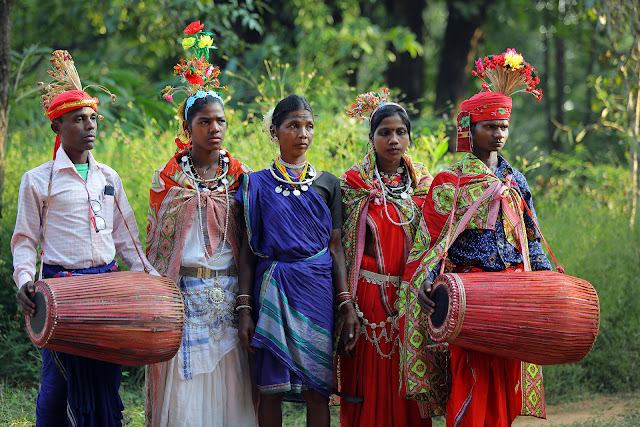Baiga Dancers of Kanha: Between Eco-tourism and Contemporary Art
 |
| The Baiga dance charged with animistic frenzy. |
The young nexus forged between the agents of responsible ecotourism - Jungle Lodges, and the traditional denizens of the forests - the Baigas, now presents a one-off opportunity which has the potential to push the artistic capacities of these tribal communities from the art-historical categories of the ‘primitivist’, ‘tribal’ or ‘folk’ to that of ‘dynamic contemporaneity’. This relationship provides and promises greater exposure to the indigenous art forms of India. It also generates employment for the local people and adds a new dimension in perceiving these tribal groups. In return, the jungle lodges inject much needed revenue into the local economy, provide medical and economic securities to their local employees and help the tribal artists garner a much wider array of viewers, and possibly, patrons. Through an acknowledgement of these communities’ artistic agencies as being relevant to the present, it seems plausible that other culturally sidestepped communities elsewhere in India would get an opportunity to break out of the retrograde and vicious cycles of cultural marginalisation.
 |
| Mahua-Jod Open air theatre at Serenity Jungle Retreat. |
The cultural arena where one can observe ecotourism and contemporary art uniting in productive symbiosis is that of the jungle lodges of Kanha National Park, Madhya Pradesh. These jungle lodges become a microcosm of the urban civilization amidst the largely rural and remote areas of the country. Correspondingly, the largely urban museums and art galleries of Indian cities are the ones which, owing to their scholarly expertise and conventional legitimacy, define, promote and shelter various expressions of contemporary art. However, if one was to broaden the definitive frameworks of such institutions as being Spatio-temporal complexes that include and represent the contemporaneity of present times, conversely then, the performance sites situated within the premises of the jungle lodges emerge as unique heterotopia which can be said to encapsulate the ‘artistic contemporaneity’ of the Baiga community.




Comments
Post a Comment